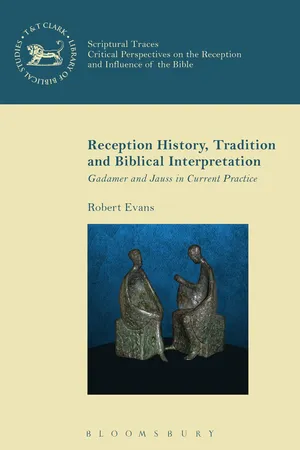
Reception History, Tradition and Biblical Interpretation
Gadamer and Jauss in Current Practice
- 272 pages
- English
- PDF
- Available on iOS & Android
Reception History, Tradition and Biblical Interpretation
Gadamer and Jauss in Current Practice
About This Book
This study seeks to make a contribution to current debates about the nature of Wirkungsgeschichte or reception history and its place in contemporary Biblical Studies. The author addresses three crucial questions: the relationship between reception history and historical-critical exegesis; the form of reception history itself, with a focus on the issue of which acts of reception are selected and valorized; and the role of tradition, pre-judgements and theology in relation to reception history. Disagreements about these matters contribute to what many characterise as the fragmentation of the discipline of biblical studies. The study champions the hermeneutics of Hans-Georg Gadamer as a theoretical resource for understanding biblical interpretation, and a way of holding together with integrity the varied activities undertaken within the discipline. Each aspect of the argument is illustrated, tested and further explored with reference to the post-history of exhortations in the New Testament to 'be subject'. These have been widely cited and applied for 2, 000 years – in literature, law and politics as well as in theological traditions. In this way the study makes a contribution not just to the theory but also the practice of reception history.
Frequently asked questions
Information
Table of contents
- CONTENTS
- Abbreviations
- Acknowledgments
- Glossary of Key Hermeneutical Terms
- Chapter 1 -- INTRODUCTION: IMPULSES AND PARAMETERS OF THIS STUDY
- 1.1. Reception history: the terms in use
- 1.2. The case study
- 1.3. The argument
- Chapter 2 -- RECEPTION HISTORY AND HISTORICAL-CRITICAL EXEGESIS
- 2.1. Introduction: ‘the end of historical-critical method’
- 2.2. ‘One phase in the process of understanding’
- 2.3. The reconstruction of the ‘horizon of expectation’
- 2.4. The contested ‘priority’ of historical-critical interpretation
- 2.5. Interim summary
- Chapter 3 -- THE CASE STUDY AND HISTORICAL-CRITICAL TOOLS: GENRE AND THE ERWARTUNGSHORIZONT
- 3.1. Introduction
- 3.2. The genre of letter, with a focus on Romans
- 3.3. The genre of paraenesis
- 3.4. The genre of Haustafel
- Chapter 4 -- THE CASE STUDY AND HISTORICAL-CRITICAL TOOLS: LEXIS AND THE ERWARTUNGSHORIZONT
- 4.1. Introduction
- 4.2. Hupotassein in Greek literature; and the influence of Psalm 8.6
- 4.3. Hupotassein and indicative statements in Pauline texts
- 4.4. Be subject to the governing authorities
- 4.5. Wives, be subject
- 4.6. Be subject to one another
- 4.7. Hupotassein and the rest of the New Testament
- 4.8. Interim case-study evaluation (Chapters 3 and 4)
- Chapter 5 -- THE CASE STUDY AND HISTORICAL-CRITICAL TOOLS: SOCIO-HISTORICAL SETTING AND THE ERWARTUNGSHORIZONT
- 5.1. Introduction
- 5.2. Romans 13.1
- 5.3. Colossians 3.18 and Ephesians 5.21-22
- 5.4. Interim case-study evaluation
- Chapter 6 -- RECEPTION HISTORY AND THE PROGRESSIVE PROCESS
- 6.1. Introduction: what process?
- 6.2. ‘Structures of exemplary character’
- 6.3. ‘Acceptable limits of diversity’
- 6.4. The ‘horizon of lived praxis’
- 6.5. Interim summary
- Chapter 7 -- THE CASE STUDY: CONTOURS OF A TRADITION IN THE CHURCH
- 7.1. Introduction
- 7.2. Patristic reception
- 7.3. Scholastic and Reformation reception
- 7.4. Subsequent tradition and application
- 7.5. Interim case-study evaluation
- Chapter 8 -- THE CASE STUDY: CONTOURS OF A TRADITION IN LITERATURE
- 8.1. Introduction
- 8.2. Contours of the earlier tradition
- 8.3. Middle English drama and poetry
- 8.4. Early modern drama, poetry and polemic
- 8.5. Nineteenth-century novels
- 8.6. Twentieth-century novels and a twenty-first-century TV drama
- 8.7. Interim case-study evaluation
- Chapter 9 -- RECEPTION HISTORY AND THEOLOGICAL HERMENEUTICS
- 9.1. Introduction: whose tradition?
- 9.2. Subjectivism, and authorial intention
- 9.3. Participation in the evolution of tradition
- 9.4. Interim summary
- Chapter 10 -- THE CASE STUDY AND THEOLOGICAL HERMENEUTICS
- 10.1. Introduction
- 10.2. ‘Specific warrants’
- 10.3. Pauline texts ‘rooted in Pauline theology’
- 10.4. ‘Conscious’ and ‘unconscious’ authorial intention
- 10.5. The Trinity, the cross, and subordination
- 10.6. Interim case-study evaluation
- Chapter 11 -- CONCLUSION
- Bibliography
- Index of References
- Index of Authors